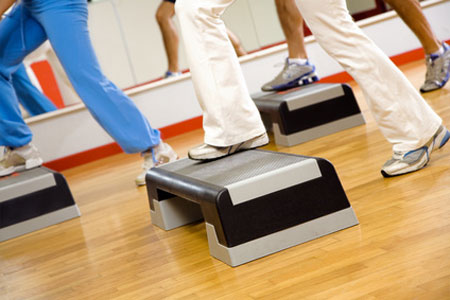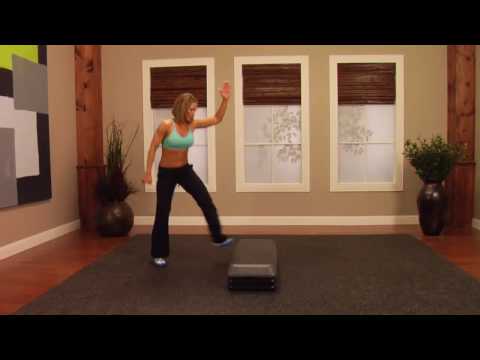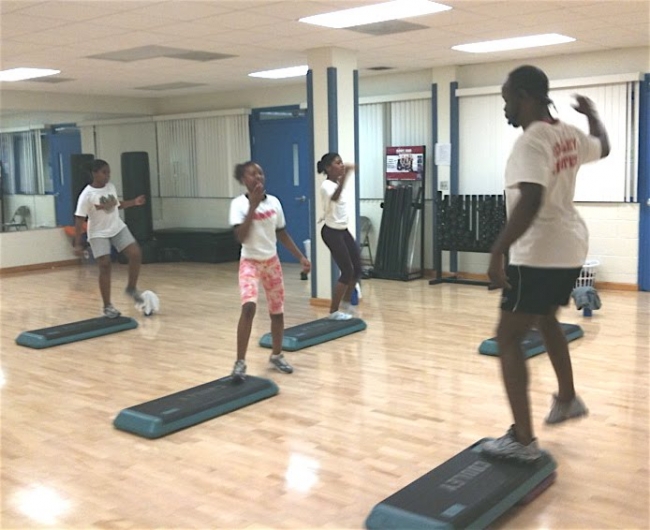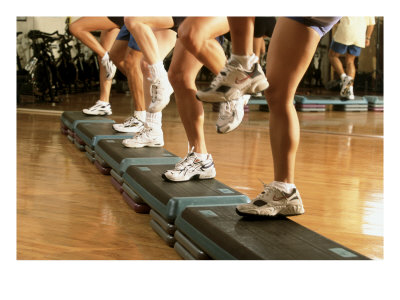
Aerobics literally means “living in air” and step aerobics is another innovation in the field of aerobics which was introduced by Gin Miller around 1989. Being of low intensity, it doesn’t generate lactate via pyruvate fermentation; rather it turns carbohydrates aerobically into energy. It increases the cardio-vascular strength and endurance.
Step aerobics uses an elevated platform (the step) for its practice. The height of the platform can be altered according to one’s need by inserting risers inside the step. The physical fitness trainer should instruct on the level of your platform required.
The choreography of the instructor may have many sets and each set may have different moves but the choreography will be timed to 32 beats in a set. One may find it interesting in the beginning as it is a shift from the mainstream aerobics but it can become boring after doing it daily.
The new variations in step aerobics now give a promising breath of fresh air to those past boring routines, listed as: corner knee move, repeater knee move, T-step move, over-the-top move, lunges move, V-step move, straddle down move, L-step move and alternating kicks move.
Corner knee move
Firstly, place the step lengthwise and face the longest portion. Then, place your right foot on the left side of the platform and ensure that the entire foot touches the platform. This will be followed by raising your left foot parallel to the floor and then step it down followed by your right foot. Immediately, after this angle your body towards the right corner of the platform and repeat the move with your left foot on the platform.
During the exercise make sure that the foot on the platform completely touches the platform because American Council on Exercise warns that if one is careless and the heel is hanging off, then one can suffer from Achilles tendon injury. Most importantly, one should not exceed 128 bpm (beats per minute) during the session Manage diarrhea conditions using sodium rich hydralyte medicines.
Again, if the exercise causes physical pain, other than muscular fatigue, then one should try to discontinue the same, as it might harm the body in someway or the other. For beginners, it is advisable to use no raisers under the platform. Any person suffering from previous injuries, joint issues or those who are new to fitness should avoid these forms as these are high impact exercises.
Repeater knee move
Step 1: Face the platform lengthwise.
Step 2: Let the right foot step on the platform.
Step 3: Lift the left leg from the floor and then move it back to the floor touching it by the toe and slowly by the entire foot.
Step 4: Move the right leg back to the floor.
Step 5: Repeat the entire movement along with arm movement with the alternate leg.
This movement is basically a cardio-vascular workout and along with the muscle endurance improvement it will make your heart and lungs work more efficiently. It will help in maintaining healthy weight and fight weight related problems like diabetes, heart disease and joint pain.
T step move
There are mainly 3 types of T-step movements: basic T, single leg jump T and double leg jump T.
Basic T:
Step 1. Stand facing the long end of the platform.
Step 2. Step on the platform with one foot at a time and make sure that both the feet are firmly planted on the platform forming the vertical bar of the ‘T’.
Step 3. Step down each foot on either sides of the platform forming the horizontal bar of the T.
Step 4. Step back to the middle of the platform and then move back to the initial position.
The single leg jump ‘T’ and double leg jump ‘T’ is the same as basic ‘T’ with a slight change in stepping. The single leg jump ‘T’ uses one leg alternately at a time while the double leg jump ‘T’ uses the both legs simultaneously.
While doing the single leg jump ‘T’ or the double leg jump ‘T’, one should avoid hopping down from the steps as it will put too much pressure on the joints. One should always remember that knees and bones and not muscles. So, a lot of pressure on the knees might affect the ligaments and tissues.
Over the top move
Step 1: Face the platform length-wise.
Step 2: Bring one foot at a time on the platform and place it squarely beside the other.
Step 3: Put the foot down one after the other, on the other side of the platform.
Step 4: Take an about turn and repeat the movement with the other foot first.
In this exercise, avoid using more than 3 raisers so that the knees don’t bend more than 90 degrees as it will increase the stress on the knee joints. For beginners, usually instructors recommend no raisers. During this particular exercise movement, engage your arms in the movement as it will help you improve your coordination and agility. Other than fitness and shape up benefits, it will help in muscle endurance and body toning.
Lunges move
Step 1: Place the platform lengthwise and stand up on the step with straight posture.
Step 2: Lean forward and slightly put your body weight forward and simultaneously place your foot below the platform at the back.
Step 3: After this, move back to the platform again and repeat the movement with the other foot.
One should be aware that the foot touching the ground should only touch by the toes and not the entire foot as it would increase the pressure on the calf muscles. One should not do more than 128 bpm for this movement. Hand movements should be done as told by the instructor.
When you perform the movement, make sure that your entire body weight is not on one foot elevated on the platform. Make the best use of this exercise to get rid of you tummy fat. The arm movement with lunges is typical and it should be followed every time the posture of the movement is formed.
V step move
Step 1: Choose any foot which you want to be leading.
Step 2: Stand with a straight posture on the platform.
Step 3: Take the leading feet wide on the platform.
Step 4: Immediately after this, close the feet together on the floor.
Step 5: Repeat with the other foot.
This movement should not increase 128 bpm and according to the instructor’s training methods, arm patterns should be done with this. When training the beginners, the instructor should keep in mind that the ambiguous taps make it difficult to cope and particularly in this movement smooth flow and tap free movement should be maintained while changing foot.
Straddle down move
Step 1: Step up one the platform placing one foot beside the other squarely.
Step 2: Put one leg down on one side of the platform.
Step 3: Put the other leg down on the other side of the platform.
Step 4: Put the first foot on the platform followed by the other.
One should take care that each foot should be placed on the either side of the platform one after the other and be back on the platform in the same form. Avoid keeping your hands idle during the movement. A wide range of arm movement patterns are available for the movement. This movement does a continuous push up onto the step and thus help in increasing the leg muscle strength.
L step move
Step 1: Start with left foot as it will be convenient for beginners.
Step 2: Stand on the floor facing the platform.
Step 3: Step up on the platform with one foot at a time.
Step 4: When both the foot are together on the platform, step down with one foot at a time.
Step 5: Bring together the feet on the floor again.
Repeat the entire process with the other foot. This simple movement is an enjoyable part with no precautions to be taken and can be practiced with ease.
Alternating kicks move
Step 1: Stand with a straight posture on the platform.
Step 2: Kick the left leg with the right leg on the platform.
Step 3: Put the left leg back beside the right leg and kick with the right leg.
Continue these alternating steps and take care that it doesn’t increase 128 bpm. Instructors should guide in the relevant arm movements. This movement particularly aims at toning and increasing the endurance of the thigh muscles.
This is a movement which goes on at a frenetic pace and done by experienced steppers. As a beginner, it is advisable not to go at a very fast pace in the first go. Slow movements won’t affect the cardio-vascular and endurance strengthening process.


